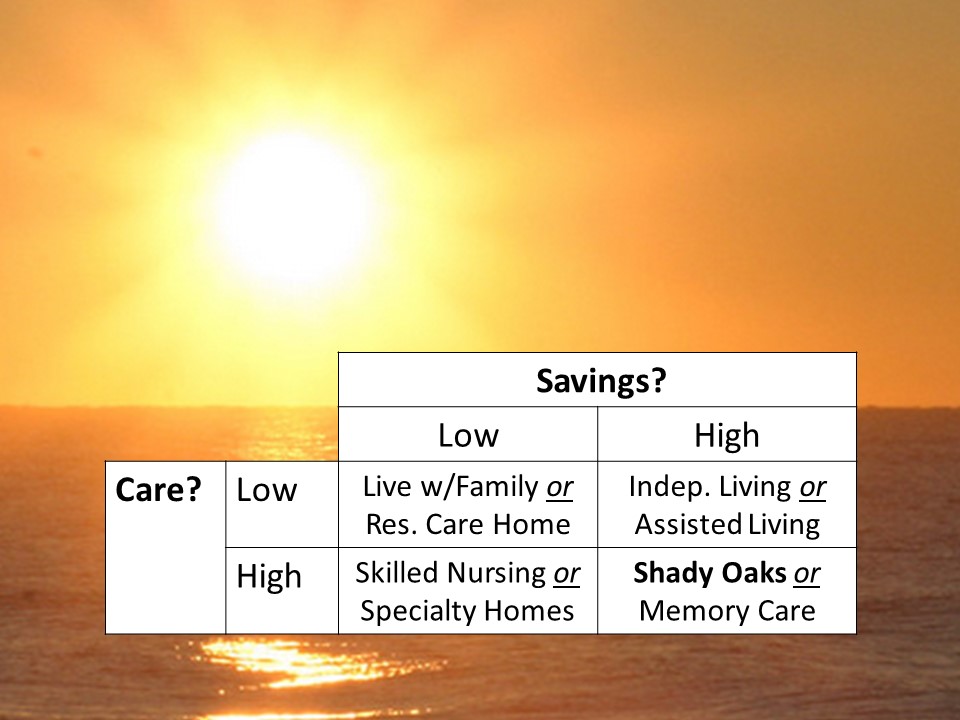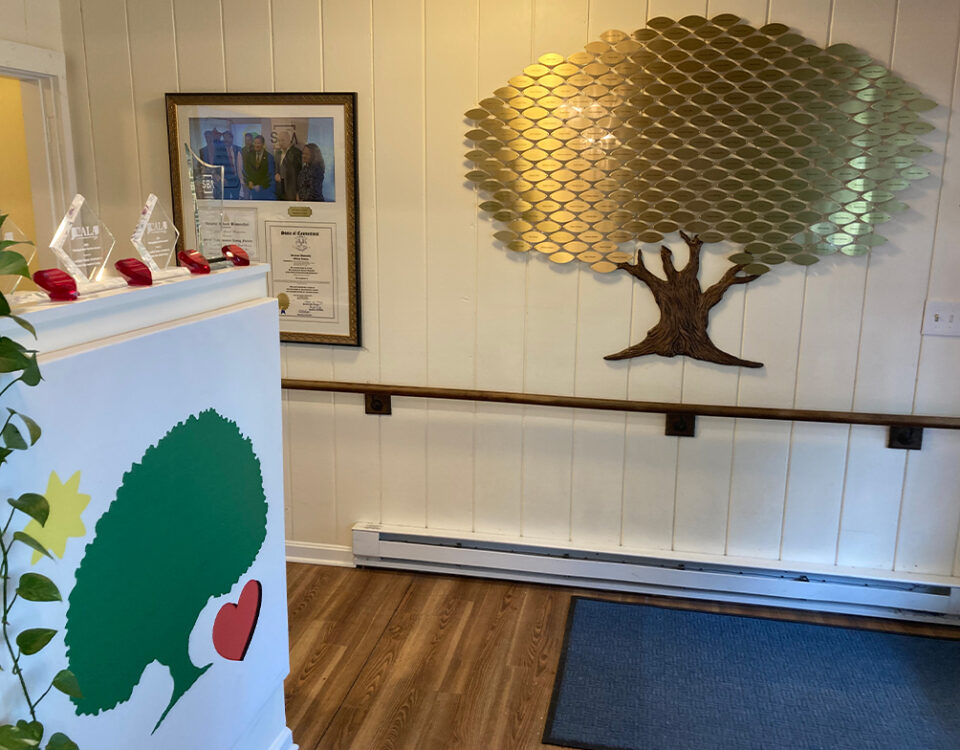
Virtual Senior Care Fair 2023
November 20, 2023
Best Elder Law Attorneys
January 3, 2024
Virtual Senior Care Fair 2023
November 20, 2023
Best Elder Law Attorneys
January 3, 2024
How To Find Senior Care
I bought Shady Oaks Assisted Living from my parents in 2016. Before that, I served three tours in Iraq as a Marine infantry officer. I feel a duty to help others. Several families asked me to write a blog “How to find Senior Care.” I hope this is helpful. I apologize for any errors. Even after seven years here, I am still learning. This is my best understanding as of Nov 2023.
Starting At Home: Beginning Care
Crisis Care: Senior care often begins in a crisis, such as a fall or grave illness, when someone calls 911. EMTs arrive and evaluate. If you agree, they take the senior to the Emergency Room. The senior returns home or is admitted to the Hospital. Seniors admitted for 3 nights qualify for Medicare paid Skilled Nursing Facility Rehabilitation. This rehab usually lasts like 3-5 weeks. It shuts off when seniors stop making progress, or it maxes out at 100 days. Seniors then return home and receive Medicare paid visits for Home Health Agency Nursing and Therapy. Such a crisis is also when many seniors start to use life alert buttons, hire in-home aides, or move out.
Home Care: Homemaker Companion Agencies provide Personal Care Aides (PCAs). PCAs help independence, socializing, and safety in the comfort of home. Some PCAs are agency staff. Others are independent. Skills vary. Agencies may charge $30 to $35 per hour. Most require minimum hours per care visit. Four hours a day is about $4,000 a month. Live-in PCAs can be over $10,000 per month. VA Aid & Attendance pension (about $2,200 vets & $1,400 surviving spouses) can help. The CT Home Care Program for Elderly (CHCPE) also helps (up to $3,000). Home Care often reaches limits by costing too much or when care needs exceed one aide help.
Moving Option #1: Needs Light Care & Has Low Savings
Family Members: For seniors with light to moderate needs but who cannot afford Home Care or Assisted Living, some move in with Family Members. This works best if family members have healthcare skills and time to help. To extra help, seniors may go to Senior Day Care Monday to Friday. Senior Day Cares have staff, recreation, and meals like Assisted Livings. They cost $100 to $150 per day. Vans may pick up and return seniors. As another supplement, families may file for CHCPE assistance to gain funds (like $2,000 to $3,000 monthly) to pay for some Home Care hours. CHCPE also has options for compensating caregiver family members.
Residential Care Homes: Residential Care Homes are a great option for light care seniors with low savings. Most have fewer than 25 residents. They offer basic meals, rooms, and care. Some help seniors, and others help younger people. Their key advantage is Medicaid. They may charge like $8,000, but residents who run out of money can stay using Medicaid. Because they are “free,” most have long wait lists. Some do not have Medicaid but subsidize rents. There are 79 in Connecticut. The Shady Oaks “Medicaid” blog has a list of them. Some good RCHs are attached to nursing homes. When care needs increase, residents usually move to nursing homes.
Moving Option #2: Needs Light Care & Has Savings
Apartments: Senior Apartments are great when neighbors help each other. Most residents drive and make their own meals. Prices are like $2,000 to $3,000. Some homes are subsidized. For options, call Bristol Housing Authority (860-582-6313). One step up is Independent Living. Independent Livings offer apartments with community meals and group recreation. Some homes have imbedded PCAs. This can save money vs. Home Care because aides can visit with shorter minimum on-site hours. Prices typically range $3,000 to $5,000 per month, not including PCA care costs. Independent Livings often reach limits when seniors fall or need more assistance.
Assisted Living (General Care): Assisted Livings combine grand hotel living (community meals and recreation) with team care (care aides, nurses, and doctors). Staff help at scheduled times, coordinate care, and respond to emergencies. Prices range $5,000 to $10,000, depending on apartments and care needs. VA pensions help. 1 in 4 assisted livings allow CHCPE aid. Most assisted livings prioritize recreation, plus light to moderate care. Because they are so big, many homes struggle when residents fall, need unscheduled bathroom help, or use wheelchairs. For safety, they may require one-on-one aides. Costs can then jump to over $15,000 per month.
Moving Option #3: Needs High Care & Has Savings
Shady Oaks Assisted Living: Shady Oaks is like a bed and breakfast with 24/7 personal care. Our moral purpose is to help seniors who otherwise need nursing homes or one-on-one aides. We are higher care vs. other assisted livings. We are more affordable vs. live-in homecare. We are more cozy vs. nursing homes. 70% of residents use wheelchairs. 40% use two-person lifts. Many have dementia but not extreme behaviors or wandering. 95% pass here. Rates often run $7,000 to $10,000. Many residents have VA and/or CT aid up to $5,000/month. Only 6 residents ever got COVID here. Bristol Press readers voted us Best of Bristol in ’23, ’22, ’21, and ’20.
Assisted Living (Memory Care): Seniors with dementia struggle with making new memories and may feel lost or wander. Some fall more and lose mobility. Some have extreme behaviors. Memory Care Homes meet these needs with passcode exit doors, specialized recreation plans, and higher aide staffing. Most Memory Cares are imbedded in General Care assisted livings. Prices range $7,000 to $12,000, depending on rooms and care. Some Memory Cares emphasize moderate assistance, so they may expect residents to someday hire one-on-one aides or leave to seek skilled nursing facility care. Some memory cares do more, so residents can pass there.
Moving Option #4: Needs High Care & Has Low Savings
Skilled Nursing Facilities: In addition to Medicare rehabilitation, Skilled Nursing Facilities provide long term care to seniors with high care needs. Connecticut has over 200. They promise strong teams of 24/7 aides, nurses, therapists, and doctors. They can help almost any care need. Some specialize. They often charge up to $20,000 per month, and residents are expected to pay this if they have it. However, most accept Medicaid so residents can stay even after they run out of money. Quality levels vary. Some have long wait lists. It is best to sign up for several and before you need care. See www.medicare.gov for lists by zip code, phone numbers, and ratings.
Specialty Homes: Some nursing homes, RCHs, and assisted livings are together in a Campus. This helps spouses stay together. A few hospitals and nursing homes have Medicare/Medicaid Behavioral Health options for seniors with extreme behaviors. A few hospitals and hospice agencies have Medicare paid Hospice Units for dying seniors who suffer unmanaged symptoms. For people under 65, Community Residences Inc. has very high care Medicaid paid small homes. Finally, if none of the above options fit, I recommend calling Connecticut Community Care Inc. (CCC) at 866-845-2224. CCC is a statewide non-profit that advises people on care options.



